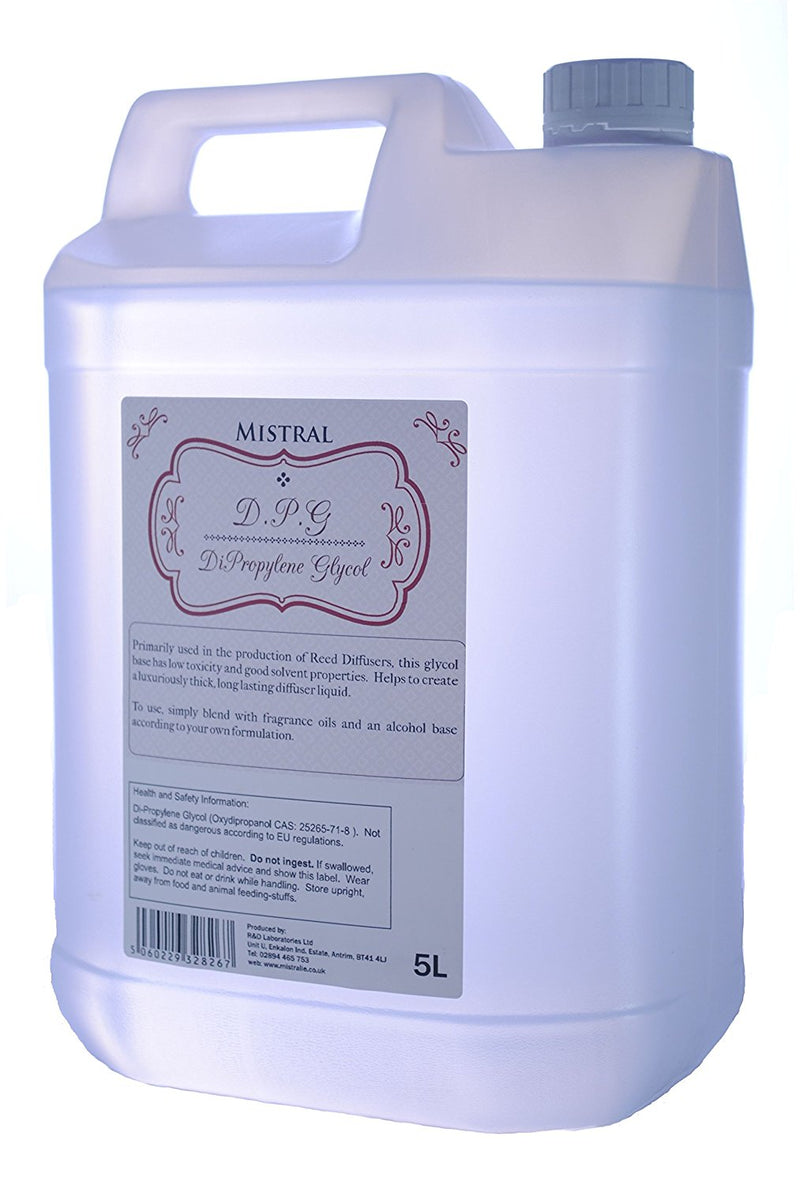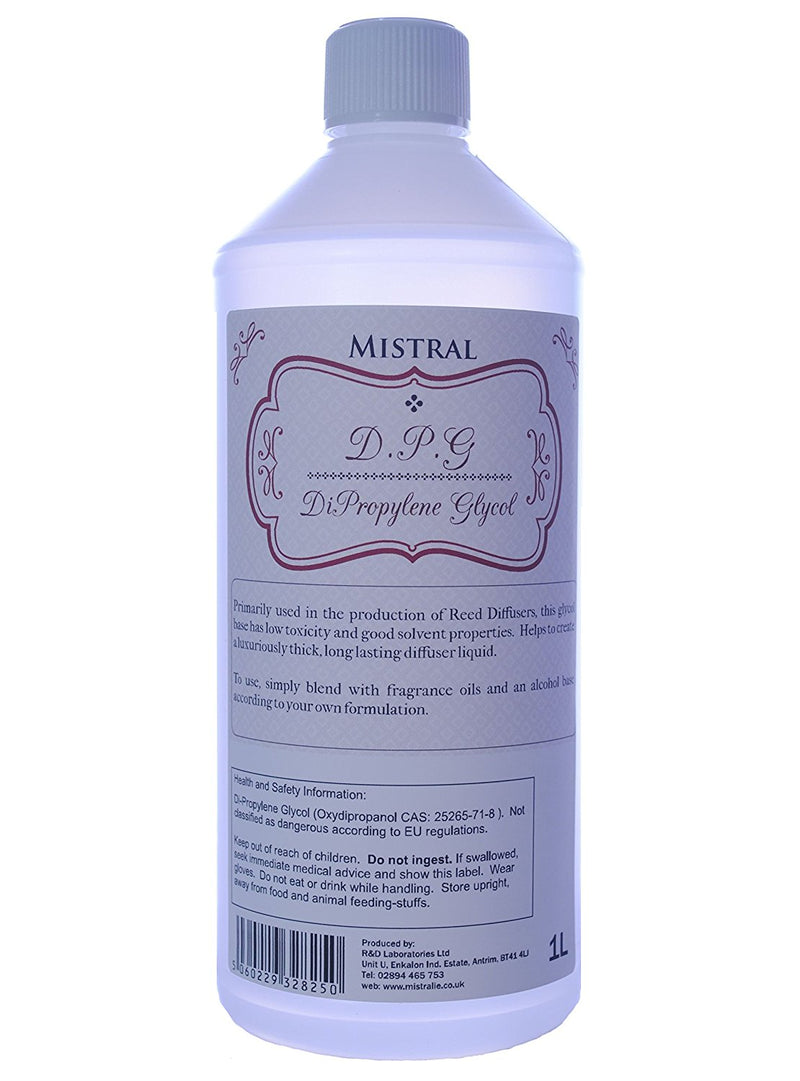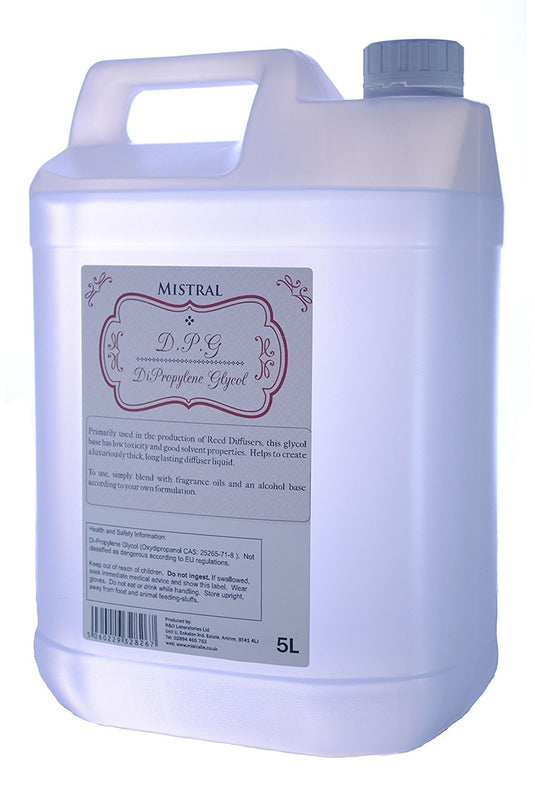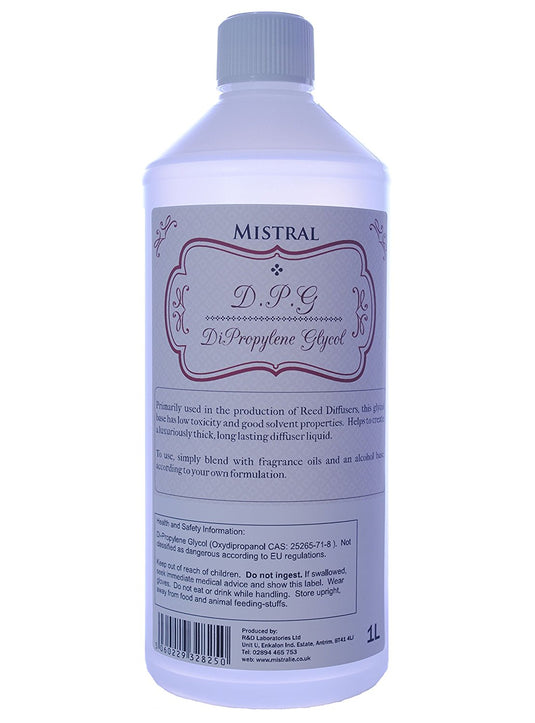

DPG LO
DIPROPYLENE GLYCOL
Low Odour - Fragrance Grade
Cosmetic Grade
Dipropylene glycol with low odour is a high quality grade and with it's low toxicity and solvent properties makes it an ideal additive for perfumes and skin and hair care products. It is also an ingredient in commercial fogging fluids which are used in entertainment industry smoke and haze machines. Ideal for use as a base for Reed Diffusers including Plugin electric types.
Personal Care and Cosmetics:
- Humectant and Moisturizer: DPG is used in formulations for skin care, hair care, and other personal care products (e.g., lotions, creams, deodorants) due to its ability to retain moisture and prevent skin dryness.
- Fragrance Carrier: DPG is commonly used in perfumes and fragrances as a carrier or solvent. It can be used to formulate alcohol-free Perfumes (see below for more details).
- It helps dissolve fragrance oils and facilitates their even distribution in formulations, improving the scent profile and stability. Making Reed Diffuser oils (see below for details). Pot pourri, perfumes, room sprays, body sprays, oil burners and Plugin reed diffusers
- Emulsifier: DPG helps blend water and oil-based components in cosmetics, improving the texture and consistency of products like creams and lotions.
- DPG is commonly used as a fragrance fixative in perfumes.
Benefits of Dipropylene Glycol:
- Low Toxicity: DPG is considered less toxic than similar glycols, such as ethylene glycol, making it a safer option in many applications.
- Versatile Solvent: Its ability to dissolve a wide range of substances makes it highly valuable in both industrial and cosmetic formulations.
- Low Volatility: Its low volatility means it evaporates slowly, making it suitable for applications where a long-lasting effect is desired, such as in perfumes or heat transfer fluids.
- Moisturizing Properties: DPG helps retain moisture, which is why it’s often included in personal care products to keep skin hydrated and soft.
Industrial Applications:
1. Solvent in Industrial and Commercial Applications:
- Solvent for Resins and Dyes: DPG is used in industrial processes as a solvent for resins, dyes, and pigments in inks, coatings, and adhesives. Its solvency properties help dissolve various chemicals, ensuring a uniform mixture.
- Antifreeze and Coolants: DPG is used in the production of antifreeze and coolants because of its low toxicity compared to alternatives like ethylene glycol. It helps lower the freezing point and increase the boiling point of liquids, making it suitable for heat transfer fluids.
- Paints and Coatings: In the paint and coatings industry, DPG serves as a solvent and viscosity regulator, improving the flow and application of paints, varnishes, and coatings.
3. Polymer and Plastics Industry:
- Plasticizers: DPG can be used as a plasticizer in the manufacturing of plastics, enhancing the flexibility and workability of polymers.
- Polyurethane Production: It is used as a raw material in the production of polyurethane foams and resins, which are widely used in the furniture, automotive, and construction industries.
4. Deicing Fluids:
- Aircraft Deicing: Due to its hygroscopic nature and low freezing point, DPG is used in deicing fluids for aircraft, ensuring that ice does not form on critical surfaces during cold conditions.
How to make your own REED DIFFUSER OIL:
- 10-20% Fragrance oil
- 60-70% DiPropylene glycol (DPG) or MonoPropylene glycol (MPG)
- 10-20% Perfumers alcohol or Formulators (optional)
To make diffuser oil, blend the fragrance oil with the DPG or MPG until clear. Add Perfumers alcohol to reduce viscosity to desired thickness.
The addition of Perfumers Alcohol is optional but it does improve clarity of finished product and allows more control of the viscosity of the Reed Diffuser.
To read an article on how to make your own Reed Diffuser click here
Using DPG to create alcohol-free Perfumes:
Why Use Dipropylene Glycol in Perfume Formulation:
-
Solvent for Fragrance Oils: DPG is a highly effective solvent for essential oils, fragrance oils, and aromatic compounds. It ensures that these oils are evenly distributed throughout the perfume, preventing the scent from becoming too concentrated in certain areas.
-
Non-Volatile: Unlike alcohol, which evaporates quickly, DPG evaporates very slowly, making it ideal for long-lasting fragrances. This slow evaporation rate allows the fragrance to stay on the skin for an extended period. It is commonly used as a fragrance fixative in perfumes.
-
Low Odour: DPG has a very faint odour, allowing the true scent of the fragrance oils to shine through without interference. It doesn't affect the fragrance profile, which is important in creating perfumes.
-
Skin-Friendly: DPG is mild and generally safe for use on the skin, making it suitable for personal care products like perfumes. It is often used in low concentrations, which minimizes the risk of skin irritation.
-
Stable in Various Conditions: DPG helps to stabilize perfume formulations, preventing the separation of fragrance oils and increasing the shelf life of the product. It works well in different environmental conditions without altering the fragrance.
How to Use Dipropylene Glycol in Perfumes:
- As a Carrier Base: DPG can be used as the primary carrier for essential oils or synthetic fragrance oils, replacing alcohol in the formulation. This creates a more concentrated, longer-lasting perfume.
- In Oil-Based Perfumes: DPG can be combined with other carrier oils (like jojoba or coconut oil) to create alcohol-free, oil-based perfumes with a smooth texture.
- In Dilution: DPG is often used to dilute strong fragrance oils to prevent them from being too overpowering. It ensures that the scent releases gradually and lasts longer on the skin.
Formulation Example for Alcohol-Free Perfume with DPG:
- Dipropylene Glycol: 70–90%
- Fragrance Oils (Essential Oils or Synthetic Fragrances): 10–30%
Advantages of Using DPG for Alcohol-Free Perfumes:
- No Rapid Evaporation: DPG doesn’t evaporate as quickly as alcohol, leading to a slower and more even release of fragrance.
- Suitable for Sensitive Skin: DPG-based perfumes are less likely to cause skin dryness or irritation compared to alcohol-based perfumes.
- Versatile Solvent: It mixes well with a wide range of fragrance ingredients, making it suitable for both natural and synthetic fragrances.
Properties of Dipropylene glycol:
- Chemical Structure: It is a diol, meaning it contains two hydroxyl groups. It is produced as a byproduct during the production of propylene glycol.
- Molecular Formula: C₆H₁₄O₃.
- Chemical Names: oxydipropanol, oxybispropanol, bis(2-hydroxypropyl) ether, 2,2'-dihydroxydipropyl ether, 1,1'-dimethyl diethylene glycol, 1,1'-oxydi-2-propanol, 2,2'-dihydroxyisopropyl ether, 2-(2-hydroxypropyl)-1-methyl ethanol, 1-(2-hydroxypropoxy) propan-2-ol, hydroxypropyl oxypropanol
- CAS NO: 25265-71-8
- Description: Liquid at room temperature, colourless and Odourless.
- Actual Specific Gravity : 1.02140 @ 25.00 C.
- Specific Gravity : 1.01900 - 1.02100 @ 25.00 C.
- Actual Refractive Index : 1.44140 @ 20.00 C.
- Refractive Index : 1.43000 - 1.45000 @ 20.00 C.
- Assay: 99.00 - 100.00 %
- Soluble in : Benzyl Alcohol, Benzyl Benzoate, Alcohol, Isopropyl Myristate, Amyris Wood Oil
- Solubility : miscible with Water
- EINECS: 246-770-3
- FORMULA: CH3-CH(OH)-CH2-O-CH2-CH(OH)-CH3
- CONTENT: Min 99 %
Health & Safety:
Labelling according to Regulation (EC) No 1272/2008: The product is not labeled as dangerous according to Regulation (EC) No. 1272/2008

